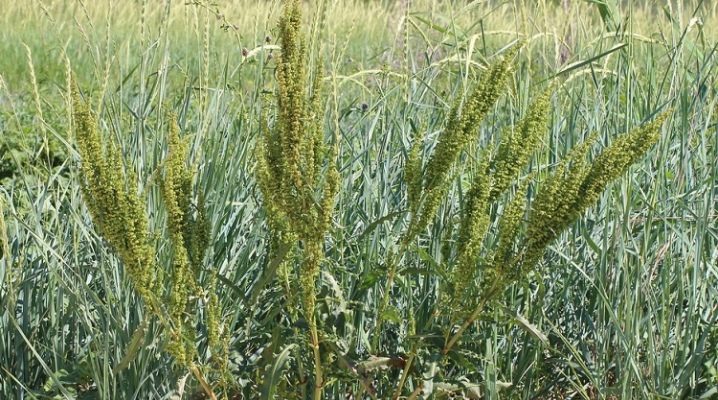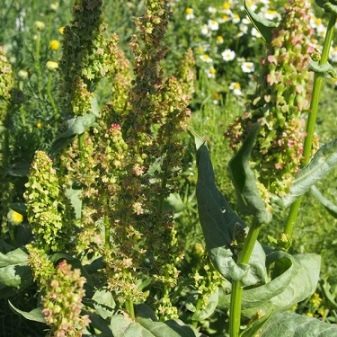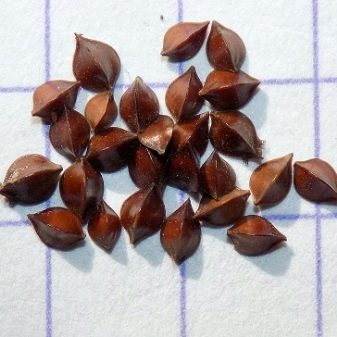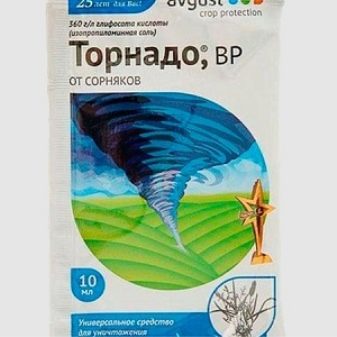All about curly sorrel

Curly sorrel has become widespread in folk medicine, but on the site it can become a malicious weed. The article will talk about curled sorrel, its description, places of growth, cultivation and much more.
Description
Curly sorrel is a species of herb from the buckwheat family (Polygonaceae). Taproot, long, brown. The stem is erect, red, reaches 50-120 cm in height, has no pubescence. Leaves are lanceolate, oval in shape, pointed, curly edges, up to 20 cm long. The flowers of the plant are small, light red or completely green, collected in a long - up to 60 cm - dense, narrow complex inflorescence.
The formula of the sorrel flower is as follows: * ОЧ3 + 3Т6П (3). The fruits look like a small triangular nut, located between the perianths and placed on a reddish shade, appear in late August - early September. Both fruits and leaves have a sour taste, for which they are appreciated by culinary specialists.
The root system is rapidly regenerating, strong, which turns curly sorrel into a weed that is difficult to remove.


Growing places
Curly sorrel was first discovered in Japan. The plant is found in many regions of Europe, Asia, America, Russia and the CIS countries. It grows in Siberia, on the coast of Kamchatka, in Primorye, in St. Petersburg and Arkhangelsk. It grows as a weed near rivers, ditches, roads, on the outskirts of meadows and fields.
Due to its great love for moisture, this plant often lives in marshy areas. Curly sorrel loves moist, moderately acidic soils, as well as soils with a large predominance of clay and sand. The plant can withstand severe frosts, so it grows well even in the northern regions.
Growing
Breeding curly sorrel is an easy process, since the plant is hardy and picky to care for. For growing at home, you need to plant it in a dark place, in a well-moistened ground. The seeds of the plant are sown in the spring, immediately after the snow melts, in open ground. For this, the weather must be dry, with positive air temperature. It should be planted in shallow pits up to 1.5 cm, leaving a distance of 20 cm between the seeds.
For stable growth, regular and abundant watering of the perennial should be carried out. On non-hot days, 15 liters per bush will be enough three times a week, and on hot days, daily watering should be carried out. And you should also periodically do potassium and phosphorus fertilizing. The flowering shoots of the plant should be cut off immediately after emergence, this will provide the density of the greenery and increase the amount of useful elements.
At the onset of winter, you need to trim the aerial part of the plant, leaving 1-2 cm from the ground, and cover with a dense layer of fallen leaves or peat to form humus and protect from strong freezing temperatures. To grow curly sorrel on a plot in the same place cannot be more than 4-5 years.


How to get rid of the plant?
Due to the strong root system, high viability and rapid vegetative reproduction, curly sorrel is classified as a ruderal plant. It leads to severe clogging of the garden plot, which interferes with the development of other plants and crops growing next to it.
The negative consequences for other cultures are manifested in the following:
- the soil next to the sorrel becomes 1-4 degrees colder;
- the efficiency of fertilizing and watering neighboring plants decreases;
- the risk of diseases increases, since curly sorrel is susceptible to fungal infections that quickly spread throughout the area;
- weeding of the site is complicated due to the strong and deep roots of the plant.
Chemical methods of control include treatment with pesticides, herbicides, carbamates, etc. In the process of growth, the weed is sprayed with "Glyphosat", "Hurricane" or "Tornado".
- "Glyphosate" possesses substances that interfere with plant photosynthesis. After the solution hits the leaves, it begins to spread along the stem and roots, destroying the weed.
- "Hurricane", falling on any part of the plant, spreads through all its cells and promotes wilting of leaves and roots.
- "Tornado" - a liquid solution with which the foliage of a plant is processed, which has reached about 15 cm of growth. Through the leaves, the solution enters the roots of the weed, destroying it at the cellular level.
Agrotechnical methods include the purification of seed material from the admixture of fruits, the use of crop rotation, cleaning the soil in the spring and autumn from the roots of the weed.


Popular methods include processing with soda, vinegar, and salt.
- A high concentration soda solution is used in the fall, pouring it onto the roots of the weed. This will protect nearby plants.
- The leaves and stems of the weed should be treated with a solution of acetic acid, this contributes to its drying.
- Salt is poured onto the ground above the roots in large quantities in the fall. When it rains, the salt will dissolve, penetrate into the plant's root system and prevent new weeds from emerging. However, with this method, you should not plant vegetables for a long time.
To prevent the spread of weeds throughout the site, neutralize the highly acidic soil by adding lime to it. This procedure should be performed every 3-4 years. In the autumn period, the site should be dug up in the places where the plant grows and the remaining roots should be removed. The spreading weed should be removed in all unwanted areas. Despite the presence of medicinal characteristics of the plant, its growth on the site should be kept under control.
If you do not timely destroy the unwanted curly sorrel on the site, then the fight against it will drag on for a long time.













The comment was sent successfully.